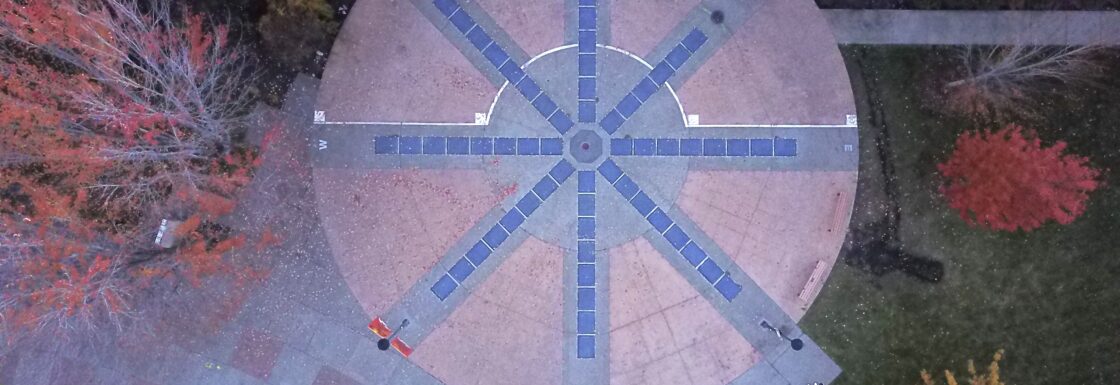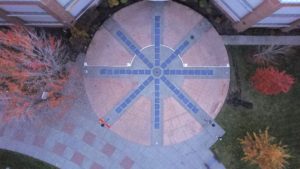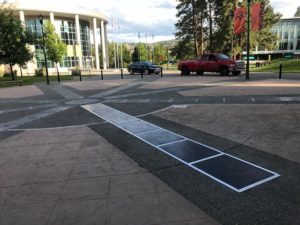The Solar Compass

Projects Sponsor
Solar Earth Technologies Ltd. began construction on Canada’s first solar sidewalk system in 2017. A small sidewalk in front of a daycare at Thompson Rivers University in Kamloops, BC was followed by a much larger and technically-complex solar array known as “The Solar Compass” in front of the Arts and Education Building. The Solar Earth team overcame many technical challenges previously considered impossible in a climate that can vary between -40C and +50C.
Solar Earth Technologies and TRU did the walk for us, and the Solar Compass project pointed us to an array of new installation methodologies and technologies learned along the way.

Arial View of the Solar Compass
In the Fall of 2015, Solar Earth Technologies Ltd. approached Thompson Rivers University’s Professor Michael Mehta, who would become project lead, about the prospect of developing a solar pilot project on their Kamloops, BC campus.
In March 2016, an internal research grant provided funding for an innovative project in a truly, astonishingly, dynamic field.
The Solar Earth team aimed to install a solar sidewalk system, and they talked that talk for a full year before deciding they could walk the walk.
Advances in solar photovoltaic technology have been significant in recent decades. The next generation of solar products will be integrated into existing infrastructure. There are already solar glass technologies, siding, and integrated roofing products. That’s close to old (sun) hat.
Mounting modules onto the ground, however, is a profoundly different task and it offers the potential to power critical infrastructure during disaster-induced outages. It is more rugged and can be thought of as a carrier technology for other services like fibre optics, in-road sensor technology, and possible “smart roads” that can work with electric vehicles. It may allow infrastructure to pay for itself over time with energy generation.
The Solar Earth team’s main objective with the sidewalk project was to develop and test the real-world application of this technology, and to bootstrap other uses in the future. To this end they explored several design options, considered technological platforms for bringing the DC power from the modules into campus buildings and single phase and 3-phase systems, and examined the CSA Electrical Code.
What happened next is that Solar Earth developed a technology and installation methodology for what many thought was an impossible task.
Thompson Rivers University partnered with the BC Sustainable Energy Association, who provided volunteers for installation. They also received several donations of labour and equipment from local companies in Kamloops. Construction of the first solar sidewalk began in July 2017, followed soon afterwards with the larger Solar Compass project. Both solar arrays were completed by October 2017.
Kamloops is a very difficult environment for this kind of technology. When mounting solar modules into existing concrete on the ground, many factors like expansion and contraction need to be considered. Temperature can vary in this region from as low as -40°C to highs of +50°C.
The first winter was very hard on the arrays, which had to be rebuilt in the spring of 2018. Stress cracks, delamination, and snow plough-induced damage were a problem for the first generation of modules. The team also had to figure out better ways to manage water and ice formation in the raceways underneath the modules, and how to support them better over the raceway.
But figure they did, and since the upgrade, the modules have been performing as expected.
More research and development of in-ground solar mounting is needed. However the majority of the modules on the Solar Compass are still intact 5 years later and if it can be made to work there (and it did!), it can work anywhere on the planet.

Solar Compass Street View
The Solar Compass was a learning and proving ground for this technology. As a result, Solar Earth has been able to deploy emergency back-up systems in Tampa, Florida and elsewhere.
Thousands of people walk over the TRU Solar Compass array daily. It’s a piece of public art that produces energy – and is also helping to change public perceptions of solar PV deployment opportunities, inspire others in this emergent field and, of course, it’s all about the new installation methodologies and technologies you learn along the way.













